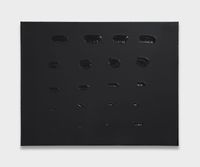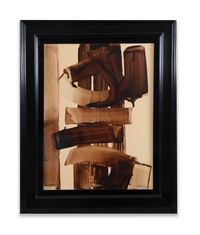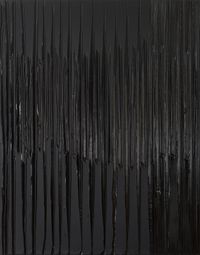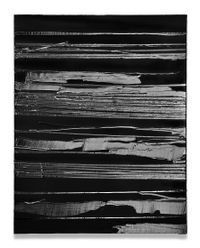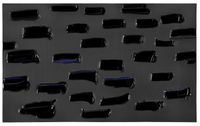Working primarily with painting and sculpture, Pierre Soulages was recognised for his experimental applications of black paint in a pursuit of producing light in darkness.
Read MoreAs a young man Soulages was aware of the works of Pablo Picasso and Paul Cézanne, who inspired him to train as a painter at the École nationale supérieure des Beaux-Arts, Paris. Soulages' early works—such as Peinture 60 x 73 cm (c. 1936), a small painting of trees on a hillside—tend towards representation; however, his rejection of the school's traditional approach to painting led him to return to his hometown of Rodez.
Soulages served briefly in the military during World War II, after which he moved to Montpellier. There, he met Russian illustrator and designer Sonia Delaunay, who introduced him to abstract art. He produced his first abstract painting in 1946, shifting from naturalistic landscapes to the calligraphic abstractions that would come to define his practice.
Black was the central concern of Pierre Soulages, who was influenced by the prehistoric charcoal cave drawings that he encountered in museums as a youth. Soulages developed various methods of applying black paint to the canvas, ranging from painting it flat on the surface to layering pigment until it became sculptural.
Soulages' first groundbreaking work was the 'Broux de noix' series (Walnut Stains) (1947–1959), made using walnut stain—commonly reserved for furniture—instead of paint.
When exhibited at the Salon des Surindépendants in 1947, the 'Broux de noix' paintings attracted attention not only for their use of an unconventional and inexpensive material but also for the bold and restrained energy embedded in them. In walnut stain and oil on paper 74 x 47.5 cm (1947), for example, broad strokes sweep across the canvas, their darkness and crackle texture in stark contrast with the lighter background.
Around the same time as he was making walnut stain paintings, Soulages increasingly concentrated on using black paint, applying it in layers on white backgrounds. In Painting, 195 x 130 cm, May 1953 (1953), thick, black slab-like strokes form a cross over a thinner wash of the shade, while exposed bits of white peek through the dark.
This juxtaposition of dark and light is also common in Soulages' prints, such as the black marks in the lithograph XXe Siecle (1970) or the ribbons of azurite blue in the silkscreen print Sérigraphie 18 (1988). Though departing from his contemporary French abstract painters in his preference for black over a colourful palette, Soulages was considered a prominent figure of the Jeune École de Paris (Young School of Paris)—loosely associated artists who made the gestural or post-Cubist abstractions—alongside Hans Hartung.
As abstract painting gained momentum in postwar Europe and America, Soulages' reputation began to extend beyond France. His work was especially supported by American curator James Johnson Sweeney and art dealer Samuel M Kootz. In 1954, the artist held one of his first solo shows in the US at Kootz Gallery in New York.
During this decade, Soulages' paintings were also included in American exhibitions of works by notable European artists, including Younger European Painters at the Solomon R Guggenheim Museum (1953) and The New Decade: 22 European Painters and Sculptors at the Museum of Modern Art (1955). Although Soulages shared with American Abstract Expressionists the use of vigorous brushwork and an affinity for the contrast between black and white, he differed from them in that he painted with a careful deliberation of his actions rather than relying on chance.
Soulages' preoccupation with light and black culminated in 'Outrenoir' ('Beyond Black'), a series of black paintings begun in 1979. The first Outrenoir painting was born by accident, when the artist realised that he had achieved something new in an unsuccessful painting: by covering the entire canvas in black, Soulages had created a surface that reflected light.
Soulages continued to experiment in a similar spirit, employing his homemade brushes and tools to layer black pigment onto the canvas and sculpt rough or smooth surfaces that bounce off light in different ways when the paint dries. In Peinture 296 x 165 cm (2014), the hardened acrylic paint forms diagonal ridges, while the short strokes created by gouging paint off the canvas recall water drops in Peinture 18 novembre 2014 (also 2014).
For more than seven decades, Soulages exhibited internationally and regularly.
In 2001, he was the first living artist to display his works at the State Hermitage Museum in Saint Petersburg; in 2009, Centre Pompidou in Paris organised a major retrospective of his oeuvre titled Soulages.
Solo exhibitions include Soulages / 2021, Lévy Gorvy, Palm Beach (2021); Pierre Soulages-Beyond Black, Opera Gallery, Paris (2020); Pierre Soulages, Musée du Louvre, Paris (2019); Pierre Soulages, Perrotin, Shanghai (2019); Beyond Black, Alisan Fine Arts, Hong Kong (2019); Soulages: A Retrospective, Fondation Pierre Gianadda (in collaboration with le Centre Pompidou Paris), Martigny (2018).
Group exhibitions include Abstract Dissonance, Gagosian, Paris (2022); The New World of Charlotte Perriand, Fondation Louis Vuitton, Paris (2019); Asian and European Postwar Masters: From Soulages to Zao Wou-Ki, de Sarthe, Hong Kong (2016); Vibration of Space: Heron, de Staël, Hartung, Soulages, Waddington Custot, London (2016); Rendezvous: Masterpieces from the Centre Georges Pompidou and the Guggenheim Museums, Solomon R. Guggenheim Museum, New York (1988); Paris-New York, Centre Pompidou, Paris (1977).
Sherry Paik | Ocula | 2022
